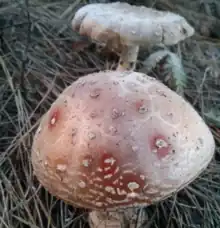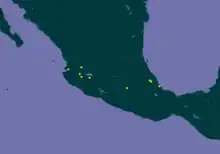Amanita yema
Amanita yema is a species of fungus in the genus Amanita, family Amanitaceae.[1] The fungi can be identified by its pileus[2] color of a red center that gradually fades into a yellow-hued edge. Growing only in forest outskirts in Mexico,[3] the fungus is a critical member of the plant biome as it is a mycorrhizal fungi.[4]
| Amanita yema | |
|---|---|
 | |
| Scientific classification | |
| Domain: | Eukaryota |
| Kingdom: | Fungi |
| Division: | Basidiomycota |
| Class: | Agaricomycetes |
| Order: | Agaricales |
| Family: | Amanitaceae |
| Genus: | Amanita |
| Subgenus: | A. subg. Amanita |
| Section: | A. sect. Caesareae |
| Species group: | caesarea |
| Species: | A. yema |
| Binomial name | |
| Amanita yema Guzmán & Ram.-Guill. | |
 | |
| Synonyms[1] | |
| |
Taxonomy
Amanita yema was identified as a species of fungus in 2001 by Guzmán & Ram.-Guill.[5] It was soon categorized under the taxa: Amanita caesarea complex[3]
Description
Standing tall with a pileus that fades from a red center to a yellow margin, this fungus stands out. With a base that ranges from a white/yellow color to an orange colored stem. Its gills, or lamelle, is also described to have a white or yellow tint.[2] Stemming out of the soil, the fungus is often found around forest edges in Mexico. The fungus is said to have a mild odor and taste,[1] but is pleasantly enjoyed.
Habitat and distribution
This mushroom is found in most temperate forests in Mexico[6] and is locally used[4] by its natives. It strives with being locally in demand, be that in the rural areas' markets or in major cities. There is a demand for this fungus in Italy, but no trade has been made with Mexico. [6] As part of the Amanita caesarea complex, it is deemed to have a high cultural significance[7] in Ixtlan.
Edibility
This mushroom is deemed to be wild edible[3] fungus, and are said to have a pleasant taste. It is almost always consumed with other mushrooms and meat. Although with its simplicity and rather small size, many eat the mushroom by its self. With a simple light washing with water[8] it is ready to be cooked. It is however, a species of fungi that is avoided, as it is similar in appearance to the toxic fungal specie Amanita muscaria. [4] Its local abundance is low,[4] which increases its worth both locally and globally.
Medicinal uses
Among the Amanita caesarea complex, A. yema is in high demand for its medicinal uses. It is frequently prepared as an anti-inflammatory[9] agent. There are other treatments the mushroom can be used for. Acting as a gastrointestinal treatment, the mushroom is boiled and its cooking water is consumed at room temperature, for renal problems.[10]
References
- "Amanita yema". www.amanitaceae.org. Retrieved 2022-05-08.
- Tulloss, R. (2009). "Notes on Amanita section Caesareae, Torrendia, and Amarrendia (Agaricales, Amanitaceae) with provisional division into stirpes and annotated world key to species of the section". S2CID 53058804.
{{cite journal}}: Cite journal requires|journal=(help) - Garibay-Orijel, R.; Cifuentes, J.; Estrada-Torres, A. (2006). "People using macro-fungal diversity in Oaxaca, Mexico". S2CID 54756404.
{{cite journal}}: Cite journal requires|journal=(help) - Garibay-Orijel, Roberto; Córdova, Juan; Cifuentes, Joaquín; Valenzuela, Ricardo; Estrada-Torres, Arturo; Kong, Alejandro (2009). "Integrating wild mushrooms use into a model of sustainable management for indigenous community forests". Forest Ecology and Management. 258 (2): 122–131. doi:10.1016/j.foreco.2009.03.051. ISSN 0378-1127.
- "Amanita tecomate". Global Biodiversity Information Facility. Retrieved 2022-05-07.
- Wild product governance : finding policies that work for non-timber forest products. Sarah A. Laird, Rebecca J. McLain, Rachel Wynberg. London: Earthscan. 2010. ISBN 978-1-84977-519-9. OCLC 659560965.
{{cite book}}: CS1 maint: others (link) - Garibay-Orijel, Roberto; Caballero, Javier; Estrada-Torres, Arturo; Cifuentes, Joaquín (2007-01-11). "Understanding cultural significance, the edible mushrooms case". Journal of Ethnobiology and Ethnomedicine. 3 (1): 4. doi:10.1186/1746-4269-3-4. ISSN 1746-4269. PMC 1779767. PMID 17217539.
- Carrera, D.; Sobal, M.; Aguilar, A.; Navarro, M.; Bonilla, M.; Saavedra, A. L. (1998). "Canning technology as an alternative for management and conservation of wild edible mushrooms in Mexico". S2CID 106394674.
{{cite journal}}: Cite journal requires|journal=(help) - Guzman, Gaston (2008). "Diversity and Use of Traditional Mexican Medicinal Fungi. A Review". International Journal of Medicinal Mushrooms. 10 (3): 209–217. doi:10.1615/intjmedmushr.v10.i3.20. ISSN 1521-9437.
- Sánchez-García, D.; Burrola-Aguilar, C.; Zepeda-Gómez, C.; Estrada-Zúñiga, M.E. (2020-11-15). "Edible, medicinal wild mushrooms: A study in Estado de México". Agro Productividad. 13 (10). doi:10.32854/agrop.v13i10.1746. ISSN 2594-0252. S2CID 228845026.
